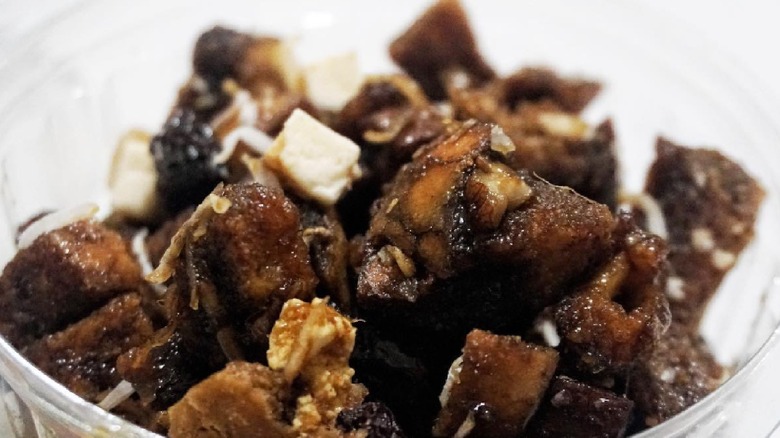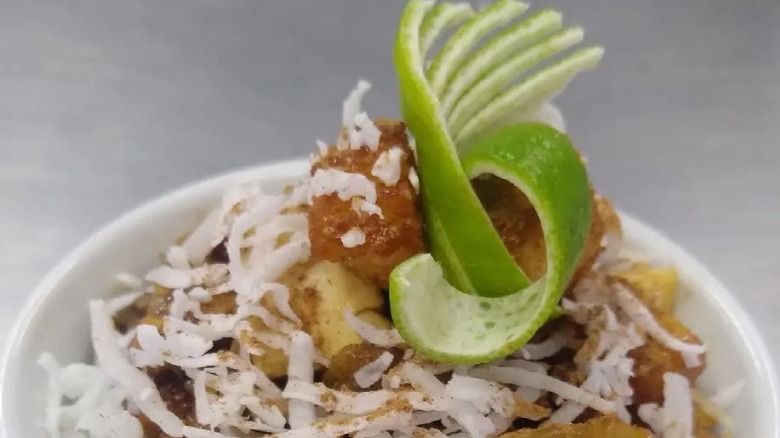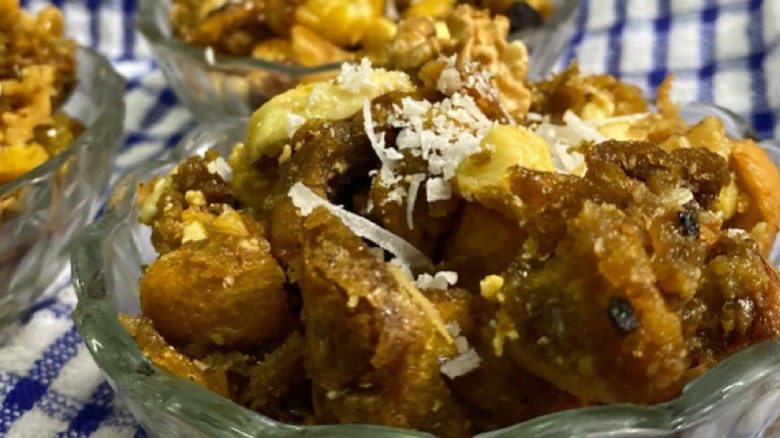Ranfañote Is The Cheesy And Nutty Peruvian Dessert You Should Know
Although so frequently overlooked, leftovers can be an ideal medium for new creative dishes. Bread is an especially great candidate for the role — a stale loaf is a different substance on a molecular level. Its contained starch molecules rearrange to a more rigid crystalline shape. Although less ideal for a sandwich, pieces of old bread offer a robust texture in applications like bread crumbs, soups, and for dessert fans, bread pudding.
In Peru, such a delicious application for stale bread is known as ranfañote. Combing dried or fried bread cubes, cheese, liquor, dried fruits, nuts, and varying sweeteners, it's a delicious medley of tastes and textures. Served in a small cup, its unassuming appearance masks the complexity of the flavor inside.
Unfortunately, ranfañote's preparation almost disappeared due to the closure of vendors nearly a century past. It's now making a deserved resurgence, specifically in Lima. Let's dive into the storied origins of the delectable dessert.
Background of Ranfañote
As with other dishes in Peruvian cuisine, ranfañote reflects the country's globalized range of influences. While its exact origins are unknown, most speculate the dish interlinks with Afro-Peruvians. During colonial times, they worked as laborers on sugar plantations south of Lima, producing chancaca, an unrefined type of sugar central to the dish. Ranfañote also includes spices like cloves and star anise, which are central to Afro-Peruvian cuisine.
However, some accredit other demographics for the dish. Theories include that ranfañote emerged as a wartime meal, repurposing bread distributed to soldiers during a war against Chile. Others cite Mestizo bakers as creators of ranfañote. No matter the originators, one quality is clear — ranfañote's a clever repurposing of stale bread.
The dessert used to be a street food staple, served in small cups by female-led vendors. However, the introduction of condensed milk and other processed sugars led to a decline in popularity. However, with a recently-invigorated Peruvian culinary resurgence, the dessert is once again back on the map.
How Ranfañote is made
The dessert starts with the preparation of the bread crumbs; it's necessary to turn leftover bread crispy. Some cube the bread, cover it in butter, and bake it in an oven, while others toast the croutons using a skillet. Meanwhile, dried fruit like cranberries and raisins are rehydrated in a liquor, typically Peruvian brandy, rum, or sweet fortified wine like sherry. Variations in ingredients and methods are common — there's not a set procedure for the dish.
Next comes the assembly of the syrup. In the most basic version, the components are simply coated in the molasses-like chancaca. However, the syrup is frequently flavored with a range of spices, like orange peel, cinnamon, cloves, star anise, and apples. The sauce is simmered down with the components until it reaches a sticky, thick consistency.
Finally comes the final assembly. Nuts like walnuts or pecans are toasted, while the dried fruit is drained from the liquor. All components are mixed together in a bowl and allowed to meld for around 20 minutes, all the while still retaining the bread's crunch. To finish, the dish is topped with grated Parmesan and served.


